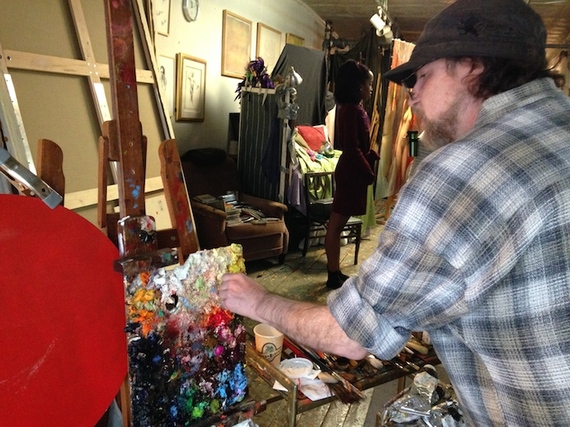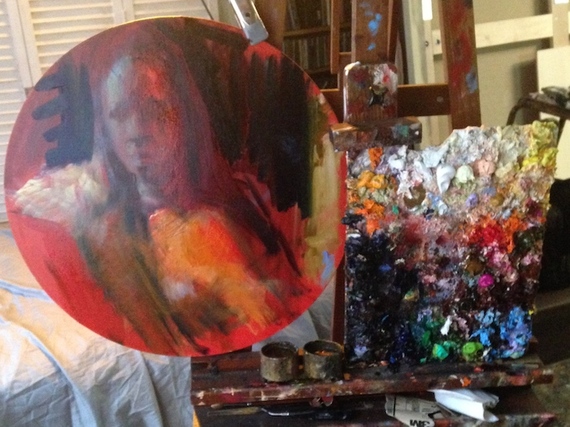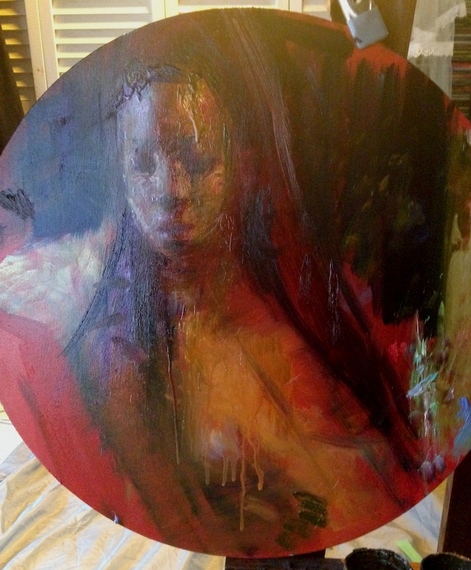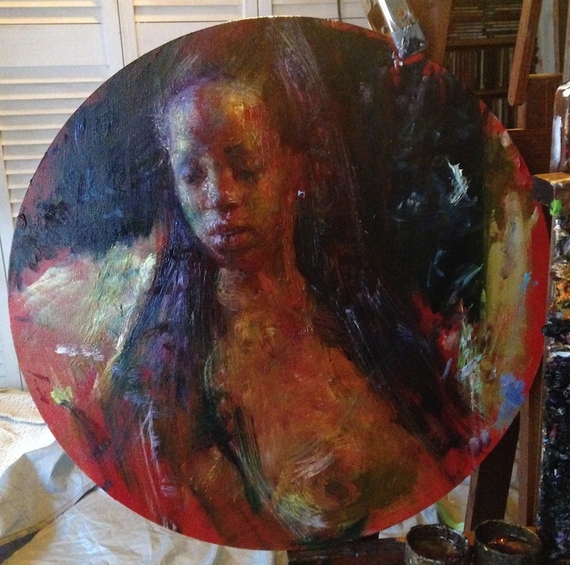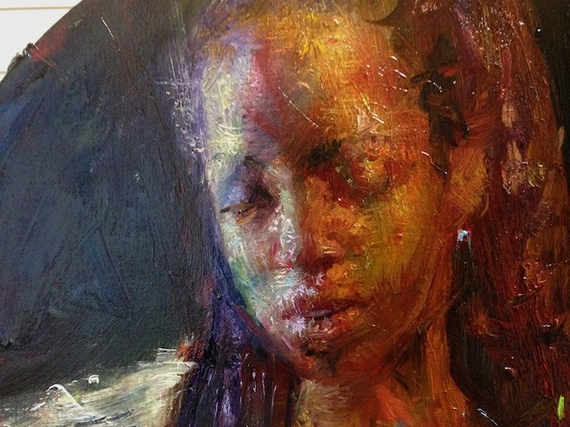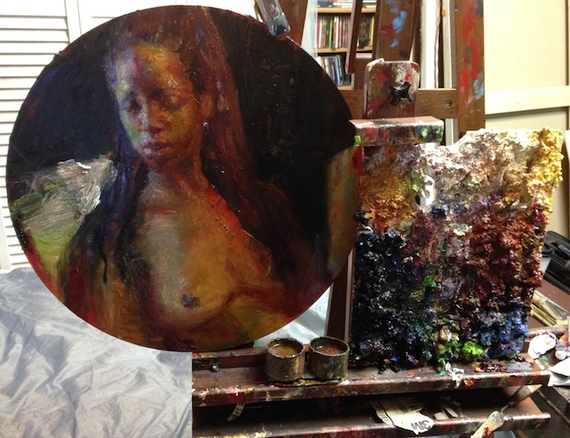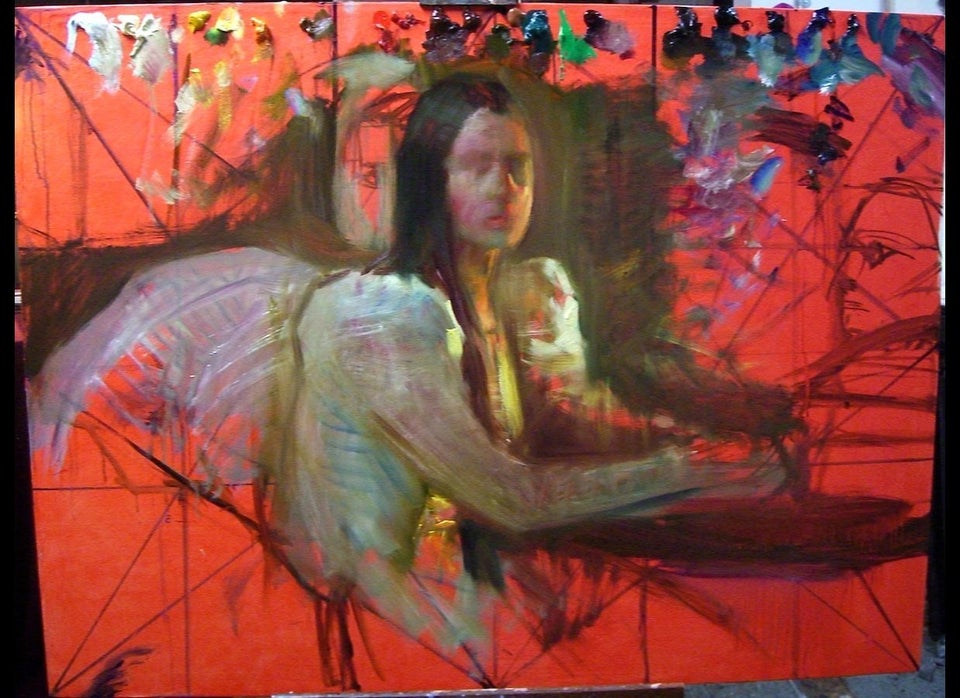I saw him paint. Steven Assael is a figurative painter, as I am. But he does not paint a thing like how I paint.
Consider the figurative painter. This painter would be moving, in the end, toward having made a picture of a person. How should the painter get there? One would imagine a series of brushstrokes, each stroke serving the purpose of creating or refining some part of the figure. That is, each stroke, each mark, serves the goal and proceeds toward it in an orderly way. And indeed, this is how I paint the figure.
It is not, however, how Steven Assael paints. I have now and then heard artists likened to the demiurge - Plato's word for the divinity that made the cosmos. This never made a visceral impression on me until I saw how Assael paints. He summons an image the way the Genesis demiurge summons the universe.
Surely you have some memory, hazy or distinct, of the famous lines -
1: In the beginning, God created the heaven and the earth.
Let's discuss this a bit. What has God created here? Yes, to be sure, heaven and earth. But he has also created distinction. Where there was no separation of things by type, now there are things, distinct from one another. Heaven, which is not earth, and earth, which is not heaven. This tells us something about God: it tells us that he had a plan.
What I mean is that if he had proceeded by impulse alone - an impulse to create - then he would have created everything as one thing. This is the simplest form of creation. The fact that he did not, reveals to us that he had fixed in his mind an idea, of two distinct entities, so that when he fashioned Being, he made not one thing only, but two distinct things.
What a revelation this is! Before being, before time - before the Beginning, as the verse says - there is a thinking God, and in the mind of this God there is already categorical reason. Reason precedes the universe and determines its fundamental structure.
This is how Steven Assael begins his painting.
We were in his studio near Bryant Park, in Manhattan, on a viciously cold day in January. He works in a broad old room four or five walkup stories above the noisy street. A gaggle of artists sat behind Assael, and in front of him, his easel and his palette. His palette held a bewildering variety of paints, wheeling from the lights to the darks, and on his easel rested a circular canvas, toned red. Beyond the canvas sat a young African-American woman, half-nude, reclining under blue daylight to the left and yellow incandescent light to the right.
Assael squinted at her, and moved the light, and pondered his canvas, and squinted at her again. Then he dipped one of his many brushes in a dark paint, and thinned it, and reaching for the canvas, he set down - four straight lines. Two vertical lines, right beside each other, and two horizontal lines, right beside each other. The paired lines crossed near the middle of the circle. He had divided the canvas into quadrants.
This was very strange. It was not a figure at all, nor even the beginning of the figure. Rather, it was a division of space: heaven from earth. Very rapidly, Assael sketched in a crude rendition of the figure, her own structure mapped over this initial cross, so that you could see each quadrant did represent a part of a figure: a head and neck in one, rib cage in another, raised arm in the third, and negative space in the fourth. There was a plan.
We return to the demiurge.
2: And the earth was without form, and void.
This "without form" is an interesting and problematic concept. The Greek has it as akataskeúastos - unfinished, a thing with its preparation incomplete. But this, like the English, is a rendering of the Hebrew, and the Hebrew is tohu vavohu, for which no absolutely reliable translation can be found. In Hebrew school, we had it as "chaos" - a primordial state of total mess, before the imposition of order. The demiurge has created the first distinctions, and filled them with being, but that being is as yet unordered.
I take the chaotic sense of the tohu vavohu here, because that's how Assael does it too. Having laid down his elemental division of the circle into merest quadrants, he proceeds to work up a chaos. There is some minimal descriptive quality to it, a faint resemblance to the broad shapes of a figure and the draperies surrounding her. But so soon as form emerges, it again subsides. As quickly as a clear and consistent color is cast, it is smeared into darkness. Each thing is written and overwritten with haphazard marks until the entire surface appears to be a brutal mess. From the red default of the canvas, Assael creates -
2: a darkness upon the face of the deep. And the Spirit of God moved upon the face of the waters.
3: And God said, Let there be light: and there was light.
4: And God saw the light, that it was good: and God divided the light from the darkness.
- yes, it is very much like this, with a couple differences: although Assael recapitulates the cosmogeny of the demiurge, he is no god. The work does not emerge from his mind, from Plato's realm of the unchanging. Assael consults the light and darkness on his model, and the clustered light and dark on his palette, and compares what the world gives him with the forms he carries in his mind. Then he throws marks upon the canvas, separating the light and dark. It is a heaving process, rooted in the sticky, roiling tohu vavohu: advancing and retreating, the figure appearing and dissolving again as he repeats her edges and shapes, adjusting without entirely erasing.
You would think he would never get anywhere, so harsh is he with his own work, so eager to tear down every conclusion he seems to reach. But over time he does make progress. We jump forward a few verses in Genesis to another insight into the process of the demiurge:
9: And God said, Let the waters under the heaven be gathered together unto one place, and let the dry land appear: and it was so.
10: And God called the dry land Earth; and the gathering together of the waters called he Seas: and God saw that it was good.
11: And God said, Let the earth bring forth grass, the herb yielding seed, and the fruit tree yielding fruit after his kind, whose seed is in itself, upon the earth: and it was so.
What we see here is a progression from the general to the specific, and from the simple to the complex. In the first hours of the creation, the demiurge asserts the absolute basics of Being. But in the days that follow, his focus narrows, and he spends as much time making smaller and smaller advances - sun and moon, stars, plants, various types of animals - as he did conjuring up the entire thing in the beginning.
My own painting technique puts me in the distinct minority among figurative oil painters. I select the region of the painting which I intend to paint that day, and I work it up from start to finish. I find this necessary because my technique involves the interaction of transparent layers while they are wet. If they dry, I can't get the effects I depend on. This puts me in a boat with the fresco painters, who also work chunks to completion because their paint must bind to the wet plaster. I have read that Vermeer worked this way as well.
On the other hand, most figurative painters seem to work from the general to the specific, "massing in" the overall painting before progressing to the details, as we see in Genesis 1:9-11. So you would be within your rights to say, "What makes Assael so special?" And I would say that it is true his general path follows the dominant practice on these matters. What makes him special is the degree and filigreed density of the chaos from which his images emerge.
He embraces the chaos, and does not seek to banish it. He continues to wrestle with it throughout his development of the image. When he finds his paint becoming too smooth, too nicely done, he acts savagely against his canvas. With my own eyes, I have seen him lunge at his easel, brush first, and bang on smooth regions of his work, spattering the paint until he has achieved a sufficiently rubble-like quality. He swipes angrily at the painting, he slaps it... there is something sadistic to the action of his larger brushes on the canvas. Surely this reads comically, and yet, if we consider it from the perspective of the creation of the image, it is a serious business. It defines the image that results.
Assael's paintings are famous for their encrusted quality. The draughtsmanship is immaculate, and yet the paint retains a volcanic frenzy. There is a seething quality to it, a buzzing vibration. His demiurgic process, hurtling from the void toward the visible, is the means of his reconciliation of these seemingly opposed qualities, of lucid drawing and feverish painting.
Seeing it, I saw a procedure which was familiar, but which I had rejected, perhaps prematurely, many years before: you make nearly undirected marks, letting the paint fall where it may. Most of the time it will be crap, but once in a while some perfect, beautiful passage will emerge - more perfect than you could conceivably have done on purpose. Remaining wakeful, you preserve this passage, and blend away the rest. You continue to throw down paint, until a network of passages remains. The chaos, of its own accord, has been tamed into the plan you secretly made at the outset. Then you continue, the delicacy of the chanced passages increasing over time, just as their scale declines. Ultimately, you have a detailed and organic whole, a painting which has painted itself, with only the lightest of guidance on your part. Theologian Teilhard de Chardin tended to think that the creation of the universe was still going on, and would culminate in a supremely complex and conscious end state which he called the omega point. This is the state of a painting when Assael completes his absurdly involved method of editing order out of chaos: a premonition of a universal omega point.
I witnessed a miniature of all these marvels in a single day, as a guest at one of Assael's painting workshops. I didn't actually intend to write about the workshop - I had already written about a drawing workshop of his, and I do not like to seem to play favorites. But his process was so fascinating, so particular, and so profound, that I am still reflecting on it, and I felt a need to share my thoughts with you here.
Assael himself, of course, had much to say, and spent hours saying it. He has thought deeply about his own work and process, and is talented at verbalizing his ideas, which are not entirely the same as my ideas. These I will neglect to share here, except for one. After a long discussion of stability in the support for a painting - canvas versus board, types of gesso, and so forth - he said, "Good craft means more than good craft." This is not directly relevant to our discussion, but there is something so touching about it, so civilized, that I wanted you to hear it. He makes assumptions of several classes of respect: respect of the artist for the work, respect of the artist for the viewer, respect of the viewer for the artist, and respect of both for the concept of art itself. In an age of mere anarchy, it sounds quaint, almost antique, to advocate for making something well. But one might argue that making well is the first task of the artist, in his capacity as mock-demiurge. Whatever other ambitions he might harbor, first he must make his artwork well, or all else will fail. It will fail to come into being, and if it does come into being, it will fail to survive.
Assael has many other ideas of vital utility to the artist, but I leave it to him to share them as he will, or to you to make your way to his cluttered old studio to sit by and watch him paint and listen to him speak. As I have said before, I scarcely believe in teachers, but if I did, I'd believe in him.
---
Steven Assael's next Manhattan workshop is scheduled for March 10-14, 2015, and will focus on Drawing and Silverpoint techniques. For further information, please contact Janet Cook at stevenassaelworkshop@yahoo.com
Website: http://www.stevenassael.com
Steven Assael's Student's Blog: http://steven-assael-student-blog.tumblr.com
